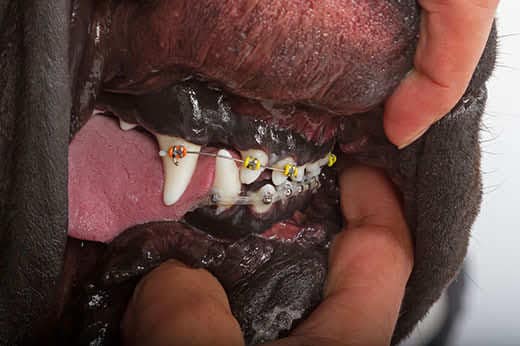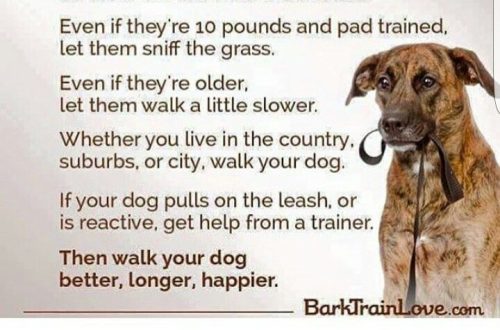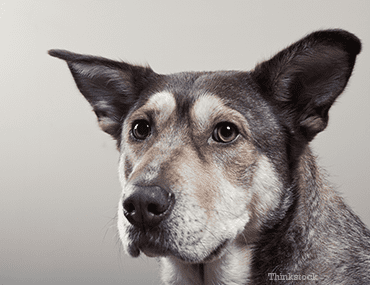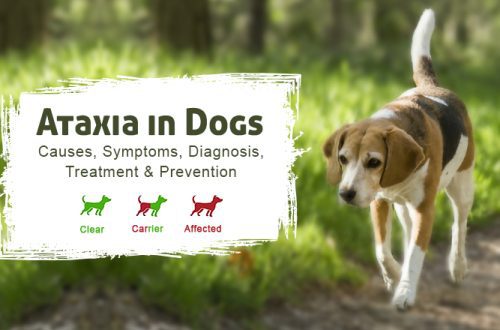
Incorrect bite in a pet: do dogs put braces
If a pet has crooked teeth or bite problems, the owner will likely want to correct the problem. One of the famous cases of orthodontic intervention is golden retriever puppy, who was fitted with braces to correct the bite, reports Patch.
Dog braces have actually been used in veterinary dentistry and orthodontics for over 30 years. It helps dogs with painful or life-threatening dental problems. And while people usually wear braces for cosmetic purposes, the goal of orthodontics in dogs is to help the dog chew and eat normally.
Contents
Is it possible to put braces on a dog
 Dog braces can help with some dental problems, including crowded and misaligned teeth. They can also be used to correct upper canine rostroversion, in which the dog’s upper canines point outward instead of down. In addition, with the help of braces in dogs, the following conditions are corrected:
Dog braces can help with some dental problems, including crowded and misaligned teeth. They can also be used to correct upper canine rostroversion, in which the dog’s upper canines point outward instead of down. In addition, with the help of braces in dogs, the following conditions are corrected:
- Linguistic version. This is a condition in which one or both canines of the lower jaw are pronouncedly tilted towards the tongue. Linguistics is often seen in dogs with long, narrow noses, such as collie. The lingvoversion is painful and does not allow the mouth to close properly. In severe cases, this condition can cause incorrectly angled fangs to pierce the palate. Linguistics is treated either with braces or removal of incorrectly growing fangs.
- Prognathia, that is, undershot. It is observed when the lower jaw is shorter than the upper.
- Remaining milk teeth. If a dog’s milk teeth don’t fall out, it can lead to crowded teeth, bite problems, and periodontal disease.
- Postoperative care. In situations where cancer treatment results in the surgical removal of part of the jaw, braces can prevent teeth from moving.
How to know if your dog needs braces
If your dog is losing food, won’t let you touch his head, is undershot, or has any noticeable changes in his teeth, it’s time to consult your veterinarian. Only a specialist can tell if a dog needs braces or if it has problemdentalcharacter. He will perform a complete medical and dental examination and report any difficulties.
Most conditions requiring orthodontic treatment are diagnosed in young dogs. This usually happens between 4 and 6 months of age when they have their adult teeth. As with humans, if a veterinarian finds a problem, they may refer the pet to a veterinary dentist who specializes in canine orthodontics. Even if the owner is skeptical about braces for dogs, if problems are found, it is worth contacting a specialist to find a treatment.
Orthodontic treatment for dogs: what is important to consider
In addition to the specific condition of a dog’s teeth, there are other factors to consider when considering getting braces for a pet.

Health status
First of all, you need to understand whether the dog is healthy enough to undergo the general anesthesia that will be required for the installation of braces. If necessary, veterinary dentists also take x-rays and clean the dog’s teeth under anesthesia. Depending on the pet’s condition and how quickly their teeth are moving, several rounds of anesthesia may be required. Luckily, the process is not as long or as complicated as it is for humans: most dogs usually wear braces for a few weeks to a few months, while humans sometimes have to wear them for several years.
Cost
The exact cost will depend on several factors, including the size of the pet, the condition of their teeth, and how long the braces have been worn. How to care for dog braces
Grooming a pet is not complicated, but requires regular brushing and examination of the dog’s teeth. By the way, this should be done regularly, regardless of whether the pet wears braces or not. If the dog wears braces, need to brush her teeth, apply oral antiseptic and inspect braces daily. In addition, the pet may need to eat soft food, plus it should not have access to chew toys and bones so that the braces do not break.
Once your dog has his orthodontic appliances removed, he won’t need a retainer to hold his teeth in place. She will be able to return to her regular food and chew toys.
Other Options for Correcting Malocclusion in Dogs
If the owner is not ready to install braces for their pet, a veterinarian or a certified veterinary dentist should be consulted. He may suggest other options such as:
- Ball therapy. This is a method of correcting slight misalignment of teeth in lingvoversion, as explained by Hale Veterinary Clinic.
- Extraction of teeth.
- Shortening of teeth by sawing.
- In most cases, braces can be put on a dog and they are an easy way to correct a pet’s dental problems.
In most cases, braces can be put on a dog and they are an easy way to correct a pet’s dental problems.
See also:
- Dog teeth cleaning and oral care at home
- How do you know if your dog is in pain?
- Changing your puppy’s teeth
- What painkillers can you give your dog?





